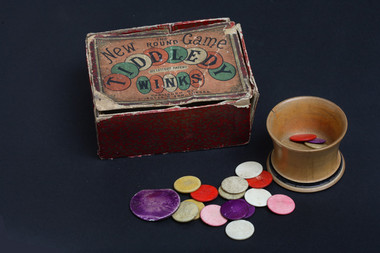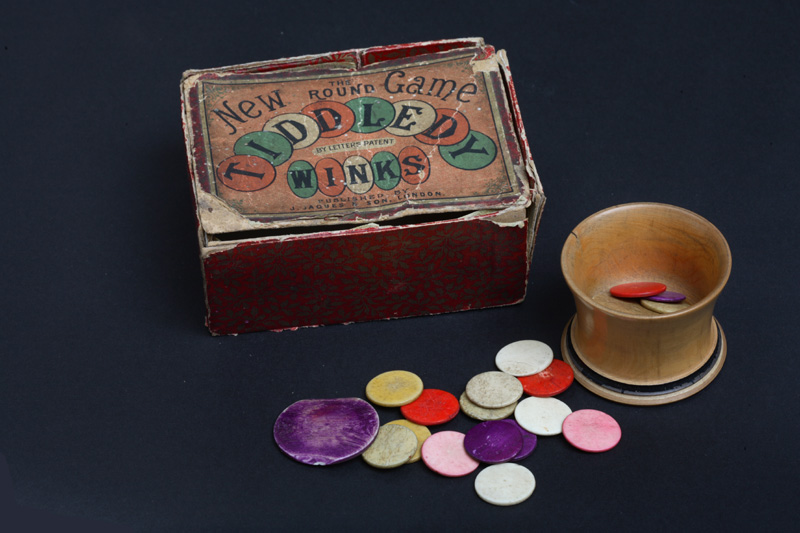Tiddlywinks, Victorian, Original
Wealthy Victorian children amused themselves in their spare time with board games, dressing up and performing plays, playing word games and learning tricks. As well as playing traditional games such as draughts, dominoes and solitaire, children played newly invented games such as halma and tiddlywinks. The game of ‘Tiddledy Winks’, as it was known then, took off from 1890 onwards and continued as a craze for almost a decade.
Tiddlywinks is a game for four players who play in two pairs. It would have been played on a table or the floor with a pot in the centre. Players used a larger disc called a squidger to flip the different coloured winks into the pot. The player who got most winks into the pot was the winner.
The tiddlywinks set shown here is original. The pieces are made from bone and the cup is made from bamboo.
Tiddlywinks is still played today.
Tiddlywinks is a game for four players who play in two pairs. It would have been played on a table or the floor with a pot in the centre. Players used a larger disc called a squidger to flip the different coloured winks into the pot. The player who got most winks into the pot was the winner.
The tiddlywinks set shown here is original. The pieces are made from bone and the cup is made from bamboo.
Tiddlywinks is still played today.

Box Height:5cm Length:11.5cm

Box Height:5cm Length:11.5cm

Wealthy Victorian children amused themselves in their spare time with board games, dressing up and performing plays, playing word games and learning tricks. As well as playing traditional games such as draughts, dominoes and solitaire, children played newly invented games such as halma and tiddlywinks. The game of ‘Tiddledy Winks’, as it was known then, took off from 1890 onwards and continued as a craze for almost a decade.
Tiddlywinks is a game for four players who play in two pairs. It would have been played on a table or the floor with a pot in the centre. Players used a larger disc called a squidger to flip the different coloured winks into the pot. The player who got most winks into the pot was the winner.
The tiddlywinks set shown here is original. The pieces are made from bone and the cup is made from bamboo.
Tiddlywinks is still played today.
Tiddlywinks is a game for four players who play in two pairs. It would have been played on a table or the floor with a pot in the centre. Players used a larger disc called a squidger to flip the different coloured winks into the pot. The player who got most winks into the pot was the winner.
The tiddlywinks set shown here is original. The pieces are made from bone and the cup is made from bamboo.
Tiddlywinks is still played today.




















